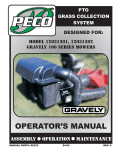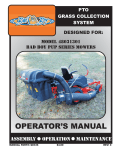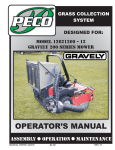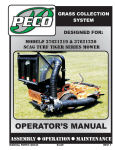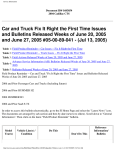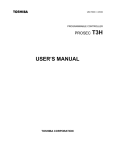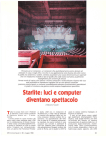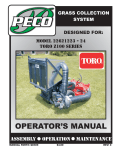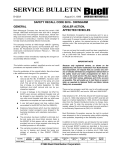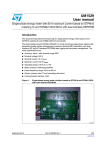Download Gravely 12031303 Lawn Mower User Manual
Transcript
P PECO PTO GRASS COLLECTION SYSTEM DESIGNED FOR: MODEL 12031303 GRAVELY 100 SERIES MOWERs OPERATOR’S MANUAL ASSEMBLY MANUAL PART#: Q0347 OPERATION $4.00 MAINTENANCE REV: 0 PTO GRASS COLLECTION SYSTEM TABLE OF CONTENTS SECTION PAGE SECTION Safety - - - - - - - - - - - - - - - - - - - - - - - - - - - - Safety Alert Symbols - - - - - - - - - - - - - - - - - - - Warranty - - - - - - - - - - - - - - - - - - - - - - - - - - I INTRODUCTION AND DESCRIPTION - - - - - - - - - - - 1-1 Introduction - - - - - - - - - - - - - - - - - - - - - - 1-2 Description - - - - - - - - - - - - - - - - - - - - - - II INSTALLATION FOR USE - - - - - - - - - - - - - - - - - - - 2-1 Preparation Of Mower - - - - - - - - - - - - - - - 2-2 Muffler Guard Installation - - - - - - - - - - - - - 2-3 Frame Mount Bracket Installation - - - - - - - - 2-4 Safety Interlock Harness Connection- - - - - - 2-5 Belt Installation - - - - - - - - - - - - - - - - - - - - 2-6 Cam Assembly Adjustment - - - - - - - - - - - - 2-7 Lower Frame To The Frame To Frame Bracket Installation - - - - - - - - - - - - - - - - - - - - - - - - - 2-8 Upper Frame Assembly Installation - - - - - - - 2-9 Top Assembly To The Upper Frame Assembly 2-10 Boot Installation - - - - - - - - - - - - - - - - - - 2-11 Length Of Hose Adjustment - - - - - - - - - - - - - - 2 2-12 Upper Hose Installation - - - - - - - - - - 3 2-13 Lower Hose To Blower Cone Installation4 2-14 Lower Hose To Boot Installation - - - - - 5 2-15 Front Weight Assembly - - - - - - - - - - - 5 2-16 Blower Cone Installation - - - - - - - - - - 5 2-17 Impeller Blade Removal/Installation- - - 5 2-18 Installation/Removal Of Collection Bags 5 2-19 Final Checks - - - - - - - - - - - - - - - - - 6 III OPERATING INSTRUCTIONS - - - - - - - - - - - - - 6 3-1 General Safety - - - - - - - - - - - - - - - - - 7 3-2 Operation & Tips On Mowing - - - - - - - - 11 3-3 Disengagement Of The Blower - - - - - - 11 3-4 Unloading The Collection System - - - - - IV MAINTENANCE - - - - - - - - - - - - - - - - - - - - - - 11 4-1 Maintenance Checklist - - - - - - - - - - - - 12 4-2 Lubrication- - - - - - - - - - - - - - - - - - - - 12 V PARTS AND SERVICE - - - - - - - - - - - - - - - - - - 12 5-1 Parts And Service Information - - - - - - - 13 Safety Decals - - - - - - - - - - - - - - - - - - - - Torque Specifications - - - - - - - - - - - - - - - Notes- - - - - - - - - - - - - - - - - - - - - - - - - - - PAGE - - - - - 13 13 13 13 14 14 15 16 16 16 16 16 16 16 16 17 17 17 18 19 20 Safety 1. Read the operator’s manual carefully and familiarize yourself with the proper use of your attachment. Do not allow anyone who is not acquainted with the Safety Instructions to use your attachment. 2. Know the controls and how to stop quickly. READ THE OPERATOR’S MANUAL! 3. Do not allow children to operate the vehicle. Do not allow adults to operate it without proper instruction. 4. Be especially watchful of children and pets darting into the area while operating. 5. Keep your eyes and mind on your unit while mowing or operating your attachment. Don’t let others distract you. 6. Do not attempt to operate your unit or mower when not in the driver’s seat. 7. Always stop unit when emptying the container. 8. Stop unit, shut off deck and attachment, set parking brake, shut off mower engine and remove spark plug wire before removing clogs or removing or replacing hose, boot, blower cone, or performing any maintenance. 9. Mow up and down the face of slopes (not steeper than 10 degrees); never across the face of the slope. 10. It is recommended that the container be kept only half full when negotiating any slopes. Start mowing on slopes when the container is empty. 11. Inspect your lawn and remove any foreign objects before mowing. Never deliberately run the mower across any foreign object. 12. Wear ear protection if the noise level is offensive. 13. Wear eye protection to prevent debris from damaging your eyes. 14. Be alert for all other traffic when driving on public roads or highways. 15. Moisture content in most grasses can damage mower and grass collector components. Also, dry grass and leaves left in the bags can be a fire hazard. Always make sure the bags are completely empty and the blower and hoses are fully cleaned before storage. 2 SAFETY WARNING! NEVER operate the unit unless the discharge guard and either the deflector assembly or the vacuum collector adapter are fastened securely in place. WARNING! Do not work around the mower deck boot or the blower area until you are certain that the mower blades and the blower impeller have stopped rotating. WARNING! To avoid serious injury, perform maintenance on the vacuum collector; ONLY AFTER STOPPING THE MOWER’S ENGINE AND WAITING FOR ALL MOVING PARTS TO COME TO A COMPLETE STOP. Set the parking brake. Always remove the ignition key before beginning maintenance. WARNING! For your own personal safety, ALWAYS mow UP and DOWN the face of slopes and NEVER across the face. NEVER attempt to mow excessively steep slopes, and use caution when turning on any slope. Safety Alert Symbol ! This Safety Alert Symbol means: “ATTENTION! BECOME ALERT! YOUR SAFETY IS INVOLVED!” This symbol is used to call attention to safety precautions that should be followed by the operator to avoid accidents. When you see this symbol, carefully read the message that follows and heed its advice. Failure to comply with safety precautions could result in death or serious bodily injury. Safety Signs The signal words DANGER, WARNING, and CAUTION are used on the equipment safety signs. These words are intended to alert the viewer to the existence and the degree of hazard seriousness. ! DANGER This signal word indicates a potentially hazardous situation which, if not avoided, will result in death or serious injury. White letters on RED ! WARNING Black letters on ORANGE ! CAUTION Black letters on YELLOW This signal word indicates a potentially hazardous situation which, if not avoided, could result in death or serious injury. It may also be used to alert against unsafe practices. This signal word indicates a potentially hazardous situation exist which, if not avoided, will result in minor or moderate injury. It may also be used to alert against unsafe practices. 3 PECO LIMITED WARRANTY FOR NEW PRODUCTS A. WHAT IS WARRANTED? PECO extends the following warranties to the original purchaser of each new PECO consumer product subject to the following limitations: 1. PRODUCT WARRANTY: Any part of any consumer product, which is defective in material or workmanship as delivered to the purchaser will be repaired or replaced, as PECO elects, without charge for parts or labor, if the defect appears within 12 months from the date of delivery of the product to the original purchaser. ALL DEFECTIVE PARTS MUST BE RETURNED TO PECO FOR INSPECTION TO DETERMINE VALIDITY OF WARRANTY CLAIMS. Freight and mailing will be borne by the customer. 2. PARTS REPLACED DURING WARRANTY: Any new PECO part which is furnished in performance of this warranty and is defective in material or workmanship as delivered to the purchaser will be repaired or replaced, as PECO elects, without charge if the defect appears within 90 days from the date of installation of such part or before the expiration of the original warranty period, whichever is later. B. SECURING WARRANTY ADJUSTMENTS. Call PECO for Return Authorization. Damaged or broken parts, other than engines or batteries, must be returned to PECO Inc., 100 Airport Road, Arden, NC 28704 before any warranty adjustment can be authorized. At the time of requesting warranty adjustment, the purchaser must present evidence for date of delivery of the product. The purchaser shall pay any charge for the product to and from Arden, NC. C. ITEMS NOT COVERED BY PECO WARRANTY. Engines and batteries attached to PECO products are covered under a separate warranty by the respective manufacturer. D. UNAPPROVED ALTERATION OR MODIFICATION. All obligations of PECO Inc., under this warranty, shall be terminated if products are altered or modified in ways not approved by PECO Inc.. E. ACCIDENTS AND NORMAL MAINTENANCE. The warranty covers only defective material and workmanship. It does not cover depreciation or damage caused by normal wear, accident, improper use or abuse of products. The cost of normal maintenance and normal replacement of service items such as belts, cutting blades, hoses, etc., which are not defective shall be paid for by the purchaser. F. NO REPRESENTATIONS ADDITIONAL WARRANTIES, DISCLAIMER. Neither PECO Inc. nor any company affiliated with it makes any warranties, representations or promises as to the quality of performance of its products other than those set forth herein. Except as described above, PECO Inc. makes no other warranties AND SPECIFICALLY DISCLAIMS ANY AND ALL IMPLIED WARRANTIES OF FITNESS AND MERCHANTABILITY. G. ANY MACHINE USED FOR RENTAL PURPOSES ARE GUARANTEED FOR 45 DAYS FROM DATE OF ORIGINAL SALE ONLY. H. REMEDIED EXCLUSIVE. The only remedies the purchaser has in connection with the breach or performance of any warranty on PECO Inc. consumer products are set forth above. In no event will PECO be liable for special incidental or consequential damages. 1. NO SERVICE CENTER WARRANTY. The selling Service Center makes no warranty on his own on any item warranted by PECO Inc. unless he delivers to purchaser a separate written warranty certificate specifically warranting the item. The dealer has no authority to make any representation or promise on behalf of PECO or to modify the terms of this warranty in any way. 4 SECTION I INTRODUCTION AND DESCRIPTION 1-1 Introduction Section II INSTALLATION FOR USE We are pleased to have you as a PECO customer. Your collection system has been designed to give you a low maintenance, simple, and effective way to collect the grass clippings from your mower. This manual is provided to give you the necessary instructions to properly mount and operate the collection system on your mower. Please read this manual thoroughly. Understand what each control is for and how to use it. Observe all safety decal precautions on the machine and noted throughout the manual. 2-1 Preparation Of Mower Carefully dismantle shipping box from around the components. Cut retaining straps and separate the parts. The collection system will have various parts located inside. Remove and sort all parts for easy identification. NOTE: Before each step of assembly it will help to study the exploded drawings on pages 8,9 and 10. NOTE: All references made to right, left, front, rear, top or bottom are as viewed from the normal operator’s position on the mower. From the underside of the mower engine remove the bolt and bushing from the electric clutch assembly. Replace these parts with the engine pulley assembly P#(A0419), 7/16” lock washer P#(K0053) and 7/16”-20 x 4” HHCS P#(K0359). The added pulley will power the collection system. Note that the center of the hub that is extended should be upward toward the engine (Figure 1-1a). Torque the bolt to 55 ft./lbs. Once pulley is secure, tie hydraulic hoses (Figure 1-1a) away from the pulley with (2) provided zip ties to prevent pulley from making contact with the hose. 1-2 Description The collection system is designed for turf maintenance where there is a need to collect the grass clippings as the mower cuts the turf. It is also good for picking up leaves and twigs in pre-season and post-season cleanup. The blower, mounted on the right side of the unit, uses a belt and gearbox system from the engine PTO shaft. Drive train protection comes through belt slippage. The blower draws grass clippings from the discharge area of the cutter deck back to the 3 - 3.3 cubic foot collection bags P#(G0002) at the rear portion of the mower frame. The operator can engage the blower with a push of the over-center linkage on the right side of the unit. Once the bags are full with clippings, they can be released to make for easy dumping. Parking Brake Setting For the added weight of the collection system, the parking brake must be re-adjusted. To do this, first Remove the rear wheels from the mower. Once removed, reset the spring and the stop gap per the dimensions in the diagram (Figure 1-1b). Replace the wheels when completed and torque each bolt to 51-72 ft./lbs. Figure 1-1b. 1.432” Figure 1-1a. 0.0” to 0.0625 Zip Tie Hose Engine Pulley 7/16”-20 x 4” HHCS 5 . Figure 2-3a. 2-2 Muffler Guard Installation Locate the two exhaust diverters (P#J0251 w/ 1-1/4” ID, P#J0250 w/ 1-3/8” ID) and clamp kit P#(X1046) provided in the hardware bag. Fasten the correct size exhaust deflector onto the mower’s exhaust and aim the exhaust as shown in Figure 2-2. Next, fasten the exhaust diverter by using the clamp kit. Right Left Figure 2-2. Mower’s Exhaust Rear Of Mower 3 Existing Bolts Here NOTE: Right and left views are as seen from drivers perspective. Figure 2-3b. Left Frame Mount Brkt. Exhaust Diverter 2-3 Frame Mount Bracket Installation To mount the frame brackets which support the bagger unit, you must first remove the existing rear bumper. This can be done by removing the three bolts and nuts attaching the bumper to each side. Set the nuts and bolts aside as they will be used to mount the frame brackets. See Figure 2-3a for bracket orientation. Mount the left frame mount bracket (Figure 2-3b) by using three of the existing bolts and three of the existing nuts. Tighten nuts and bolts. The right frame mount bracket will mount along with the PTO arm assembly (Figure 23c). Align the hole pattern on the side of the PTO arm assembly to the hole pattern on the right frame mount bracket and mower frame. Place each of the three remaining bolts one at a time through the PTO Arm assembly, the right frame bracket and through the existing holes of the mower frame. Fasten the upper hole by using (1) 3/8”-16 x 1” HHCS P#(K1191) and (1) 3/8”-16 flange nut P#(K1215). Tighten nuts and bolts. Figure 2-3c. Right Frame Mount Brkt. Use 3 Existing Bolts To Mount PTO Assy. Along With Right Frame Mount Brkt. To Tractor’s Frame. 6 Fasten Here With 3/8” x 1” HHCS 3/8” Flange Nut PTO Arm Assembly 2-4 Safety Interlock Harness Connection Figure 2-4c. The safety interlock harness is located inside of the right PTO arm assembly (Figure 2-4a). To install the harness to the mower, lift the hood of the mower for engine compartment access. Route the harness as shown towards the parking brake switch bracket on the mower (Figure 2-4b). Fasten the harness to the mower’s rear frame by using (1) zip tie P#(J0245) to prevent the harness from rubbing the mower’s tire. Next, remove the (2) bolts (Figure 2-4c) from the parking brake switch bracket for access to the brown/yellow and red/violet wires. Remove the brown/yellow wire from the parking brake switch and connect to the brown/yellow wire of the harness. Connect the red/violet wire to the parking brake switch, where the brown/yellow wire was removed (Figure 2-4d). Replace the bolts removed from the parking brake switch. Figure 2-4a. Parking Brake Switch Bolts Figure 2-4d. Free End Of Harness For Routing Harness Connected Here Figure 2-4b. 2-3 Attaching The Top Main Frame Assembly Place the top main frame assembly P#(00197800) (Figure 9) onto the main frame legs and fasten each side by using (1) 3/4”-10 x 1-1/2” HHCS P#(05959600), (1) 3/4”-10 nyloc nut P#(06540800), (1) ½”-13 x 1” HHCS P#(05947100), and (1) pivot frame handle P#(00194900). The handles are used to pivot the frame to the rear for mower engine access. Be sure that the handles are tight and the frame is in the upright position before each use! 7 Exploded View Of The A0549 - Bagger Assembly (2) K1144 - 5/16”-18 x 1” CARRIAGE BOLT (6) K1142 - 5/16”-18 x 3/4” CARRIAGE BOLT (4) K1010 - 1/4”-20 x 5/8” CARRIAGE BOLT (1) V0002 - PLASTIC TOP (2) K1126 - 1/4”-20 FLANGE NUT (1 LEFT, 1 RIGHT) B0237 - PIVOT BRACKET (2) K0037 - 1/4” FLAT WASHER (1) V1054 - INLET (1) C0048 LATCH MOUNT BRACKET (2) K1025 - 1/4”-20 x 1” CARRIAGE BOLT (1) B8002 - PLASTIC SCREEN (2) J4005 - FLEXIBLE DRAW LATCH (2) C0051 - LONG SCREEN MOUNT STRIP (2) C0052 - SHORT SCREEN MOUNT STRIP (2) C0047 - PIVOT BRACE (2) C0049 - SCREEN BRACE (1) V0005 - BAG RING SEAL (8) K1178 - 5/16”-18 FLANGE NUT (3) A0584 - BAG RING ASSEMBLY (6) J0274 - BAG RING END CAP (2) K1180 - 5/16”-18 NYLOC NUT (2) K0041 - 5/16” FENDER WASHER (2) K1153 - 5/16”-18 x 3/4” HHCS (1) A0585 - UPPER FRAME ASSEMBLY 8 Exploded Parts View 2 1 3 Exploded View Of The Blower Assembly 4 5 2 6 7 9 12 11 13 8 10 24 21 33 Exploded View Of The A0506 - PTO Assembly 32 38 22 23 28 14 17 37 19 18 16 34 15 25 35 26 36 20 31 30 29 27 40 39 41 9 Parts View (1) V1054 INLET A0553 UNIT ASSEMBLY (1) A0551 TOP ASSEMBLY (2) J6006 7”-8” HOSE CLAMPS (1) 6” x 20” UPPER HOSE (1) HB0256 HARDWARE BAG (1) 8” x 31” LOWER HOSE (1) A0546 LOWER FRAME ASSEMBLY (1) HB0257 ENGINE PULLEY HARDWARE BAG (1) A0585 UPPER FRAME ASSEMBLY (3) G0002 3.3 CU. FT. COLLECTION BAGS (1LEFT, 1 RIGHT) B0174 FRAME MOUNT BRACKET (1) E6009 BLOWER CONE 8” (3) A0584 BAG RING ASSEMBLY A0515 WEIGHT KIT (1 LEFT, 1 RIGHT) B0188 WEIGHT BRACKETS (1) A0506 PTO ASSEMBLY A0631 BOOT KIT (1) B2220 WEIGHT BAR (1) B0285 BOOT PL. (1) HB0186 HARDWARE BAG (1) E1125 BOOT (1) #HB0236 HARDWARE BAG 10 2-5 Belt Installation Loosen the (2) bolts that secure the gear box assembly P#(A0429) to the PTO mount plate (Figure 2-5a). Loosen the adjustment bolt P#(K0348) until the gear box assembly is at its far left adjustment (the gear box is moved towards the mower’s engine pulley). Connect the kevlar cord belt from the engine pulley to the lower gear box pulley (Figure 2-5b). P#(K0326) and pull the “L” end of the rod out of its hole in the cam assembly. The tension rod may then be screwed out to tighten the belt or screwed in to loosen the belt. Replace the “L” end into the top hole in the cam and replace the hair pin clip. Adjust the cam stop bolt P#(K1159) to allow the cam to rotate slightly over center when the blower is disengaged (Figure 2-6). Cam Assy. Figure 2-6. To tension the drive belt, turn the adjustment bolt clockwise until there is 1” of deflection, with 10-11 lbs. of pressure between the engine pulley and the gear box pulley. Once the correct tension of the belt is achieved, tighten the (2) bolts that secure the gear box assembly. Adjustment Bolt Figure 2-5a. Cam Stop Bolt Tension Rod 2-7 Lower Frame To Frame Bracket Installation PTO Mount Plate Figure 2-5b. Gear Box Assy. Using (2) ½”-13 u-bolts P#(K0288) and (2) ½”-13 nyloc nuts P#(K1247) , attach lower frame to the left and right frame mount brackets as shown in Figure 2-7. Make sure the lower horizontal tube is centered in regards to the lower frame mount brackets. The lower frame stiffening bracket is to be positioned towards the engine mower’s engine. Figure 2-7. Left Frame Mount Bracket Lower Frame Right Frame Mount Bracket Engine Pulley 2-6 Cam Assembly Adjustment The cam assembly P#(A0422), which controls the blower belt tension, comes from the factory pre-adjusted. If the belt is too tight or becomes too loose, remove the hair pin clip P#(K0099) from the belt tension rod Lower Frame Centered In Regards To U-Bolts Mounted To Frame Brackets 11 2-10 Boot Installation 2-8 Upper Frame Assembly Installation First, remove the deflector shield by pulling out the locking pin and lifting the shield out of deck mount tube. NOTE: During this step, it is suggested that two people install the top frame to the lower frame. Using two people to raise the top frame, lift the top frame above the lower frame making sure the bag frames are located away from the engine as shown in Figure 2-8. Slide the top frame vertical tube into the lower Frame vertical tube aligning the holes. Insert (1) ½” x 2-1/2” clevis pin P#(K0133) through the holes and fasten with (1) 5/32” x 2-5/8” hair pin clip P#(K0088). Figure 2-8. To install the boot to the mower deck, attach the boot plate mount pin P#(B0274) to the boot plate P#(B0285) using (1) 3/8”-16 x 3/4” HHCS P#(K1190) and (1) 3/8”-16 lock washer P#(K0048) See figure 2-10a. Next, loosely fasten the boot P#(E1125) to boot plate using (2) 3/8”-16 x 1” carriage bolts P#(K1182) and (2) 3/8”-16 flange nuts (P#K1215) with the head of the bolts placed from the inside of the boot. Insert the boot plate mount pin into the deck mount tube and slide the slot of the boot plate over the tab at the top of the discharge opening. Place the deflector shield in the transport position on top of the boot plate. Replace the locking pin. Adjust the boot to fit securely against the discharge opening and tighten the (2) 3/8”-16 flange nuts. See figure 2-10b for clarity. Top Frame Figure 2-10a. (1) 3/8”-16 x 3/8” HHCS (1) 3/8” Lock Washer Lower Frame ½” x 2-1/2” Clevis Pin 5/32” x 2-5/8” Hair Pin Clip 2-9 Top Assembly To The Upper Frame Assembly Installation Boot Plate Mount Pin Boot Plate Align the pivot brackets of the top assembly P#(A0551) to the pivot point on either side of the upper frame assembly. Place (1) P#(K0041) fender washer between each pivot point (Figure 2-9) and fasten each side by using (1) P#(K1153) 5/16”-18 x 3/4” HHCS and (1) P#(K1180) 5/16”-18 nyloc nut. When fastening leave nut slightly loose so that the top can pivot freely. Figure 2-9. Figure 2-10b. (2) 3/8”-16 x 1” Carriage Bolts (2) 3/8” Flange Nuts Boot Locking Plate Pin Top Assembly Here Fasten Here With 5/16” x 3/4” HHCS 5/16” Nyloc Nut Fender Washer Boot 12 Tab Exhaust Deflector in Transport Position Note: When bolting the boot and boot plate together, the head of the bolt is placed from the inside of the boot. This will prevent grass from collecting on the bolts. 2-13 Lower Hose To The Blower Cone Installation Note: The Mower’s Deflector Shield Has Been Removed In The Following Photo For Clarity. Always have the deflector shield mounted when mowing. Fasten the blower cone P#(E6009) to the blower housing by using (2) 5/16”-18 x 2-1/2” HHCS P#(K0125) and (2) 5/16”-18 jam nuts P#(K0120). Slide a 7”-8” hose clamp P#(J6006) over both ends of the lower hose. Then proceed to slide the lower hose onto the blower cone. Tighten the hose clamp. The assembly should look like Figure 2-12. 2-11 The Length Of Hose Adjustment The hoses in steps 2-12 and 2-13 must be cut to fit your machine. Follow steps 2-12 and 2-13. Do not cut the hoses until you have tried to fit them on your machine. Remember that the hoses have to be long enough to allow for enough clamping surface between the inlet, blower assembly, and the deck boot. 2-14 Lower Hose To The Boot Installation Take the unattached end of the lower hose and slide it over the circular end of the boot. Use the lower hose clamp to secure the hose to the boot (Figure 2-12). Tip: Before securing clamp rotate hose counter-clockwise (away from yourself) approximately 1” to add in retaining boot to mower deck. 2-12 Upper Hose Installation Fasten the inlet to the plastic top by sliding the inlet from the inside of the top to the outside and lock into place. Slide a 5”-6” upper hose clamp P#(J6011) onto both ends of the 6” upper hose (Figure 2-12). Then slide one end of the 6” hose onto the inlet. Make sure there is about a two-inch overlap between the hose end and the container inlet. Proceed to slide the opposite end of the 6” hose onto the outlet of the blower assembly. See Figure 2-12 for details. Make sure both ends of the hose are clearly attached to the inlet and the blower assembly inlet. Tighten the hose clamps. 2-15 Front Weight Assembly Attach each weight bracket P#(B0188) to the mower’s front casters by using (1) 3/4”-10 x 1-1/2” HHCS P#(K0364) and (1) 3/4”-10 nyloc nut P#(K1433) (Figure 2-15). When installing the 100 lb. weight you should have another person help position the weight onto a floor jack. Using the floor jack will make installing the weight much easier. Lift the weight up to the top of the weight brackets. Fasten the weight to the weight brackets by using (1) ½”-13 X 4-1/4” U-Bolt P#(K0331) and (2) ½”-13 flange nuts P#(K1246) per bracket. Once the weight is secure tighten all nuts. Be sure Weight is centered in reference to the U-Bolts. Figure 2-12. Inlet 5”-6” Clamp 6” Upper Hose 8” Lower Hose Figure 2-15. 3/4”-10 X 1-1/2” HHCS 3/4”-10 Nylock Nut Blower Boot Blower Cone Right Weight Bracket 7”-8” Clamp Left Weight Bracket Weight 13 2-17 Impeller Blade Removal/Replacement 2-16 Blower Cone Installation Thread (1) 5/16”-18 jam nut P#(K0120) onto each end of (2) 5/16”-18 x 2-1/2” HHCS P#(K0125). Now partially thread the bolts into each of the two tabs located on the blower housing. Place blower cone so the two tabs line up with the bolts then tighten completely. See Figure 2-16. Blower Housing Tabs Figure 2-16. To Remove: First remove the center bolt (#1), washer (#2) and spacer (#3) from the taper-lock bushing (#5). See Figure 2-17. Next remove the (2) 1/4”-20 bolts (#4) and place them into the threaded holes of the taper-lock bushing (next to the holes they were removed from). Gradually thread each bolt evenly into the taper-lock bushing, forcing the blade to break-away from the taperlock bushing. If the impeller will not move, hit the base of the impeller, between each vein, with a hammer, then try again. To Replace: Place impeller blade over the engine shaft. Slide the taper-lock bushing on to the engine shaft and into the impeller blade, aligning the non-threaded holes of the taper-lock bushing to the threaded holes of the impeller blade. Fasten by using (2) 1/4”-20 HHCS grade #8 bolts, (1) spacer washer and (1) HHCS bolt w/ washer. Torque to the proper specifications in the torque chart on the back of this manual. Next, rotate the impeller blade to insure that the blade is clear of contact on all sides of the blower housing. Blower Cone (2) 5/16”-18 x 2-1/2” All Thread HHCS And (2) 5/16” Jam Nuts Figure 2-17. IMPELLER BLADE 3 2 1 4 5 14 2-18 Installation/Removal Of Collection Bags Figure 2-18b. Plastic Top To install the bag onto the bag ring, first make sure the bag ring end caps are fastened to the bag ring. Place the seam openings of the bag onto the bag ring openings and turn the bag until the slot bracket in the bag ring is protruding from the opening in the bag (Figure 2-18a). Do this for each of three bags. Install the completed assemblies onto the support frame and close the plastic top. Fasten both draw latches to hold the plastic top closed (Figure 2-18b). To empty the bag, remove the bag and bag ring by lifting and sliding rearward. Grasp the loop on the bottom of the bag, turn it upside down and empty the collected debris (Figure 2-18c). Repeat for the other bags. Reinstall all bags, line with plastic bags if desired, close the plastic top and reattach the draw latches. Draw Latches Figure 2-18c. Plastic lawn and leaf bags, 33 gallon size, may be used inside the cloth bags. Be sure to leave enough plastic bag hanging over the frame so the plastic bags can be twist tied before emptying (Figure 2-18d). Figure 2-18a. Bag Ring Slot Bracket Grasp Bag Here Figure 2-18d. Plastic Bag Bag Ring End Caps Cloth Bag Cloth Bag 15 * Mow twice, at different height settings, (high, then low), if grass is extra tall. * Remember that horsepower requirements will vary with the mowing conditions such as type and height of turf grass, moisture content, amount of leaves, whether the terrain is flat or hilly, etc. 2-19 Final Checks To check the operation of the safety interlock harness perform the following: A. Start mower B. While seated in the operator’s seat, rotate the engagement handle of the collection system away from the mower. C. With the blower engaged, stand up from the operator’s seat. This action will shut off the mower which verifies proper installation of the harness. D. Check the mower’s safety interlock, see mower’s manual for more detail. NOTE: If the mower does not shut off, turn off mower and refer to page 7 to verify proper installation of the harness. If problem persists contact your local dealer. 3-3 Disengagement Of The Blower A. To disengage the blower, rotate the engagement handle towards the mower. WARNING: The blower will continue to spin. DO NOT TOUCH the blower, pulleys, or the belt until the tractor is turned off. DO NOT adjust the belt tension until the mower is turned off. Refer to section 2-6 of the manual. 3-4 Unloading The Collection System SECTION III OPERATING INSTRUCTIONS NOTE: To determine when the collection bags are full, follow the following steps: 3-1 General Safety A. Stop the forward movement of the mower. B. Disengage the mower deck. C. Disengage the blower. D. Engage the parking brake. E. Once the parking brake has been engaged, then and only then, walk behind the mower and check the collection bags by lifting the plastic hood. Load in bags should not exceed the height of the installed bag. F. To release bags from frame, lift bag ring from tab on bagger frame, slide bag out and turn bags over to deposit clippings. G. Follow steps on page 14 to re-attach bags back to the bagger. NOTE: Do not allow collection bags to become overfilled as potential damage may occur to your equipment. Also, be sure to clean the hood screen as needed. Only qualified people familiar with this operator’s manual and the mower’s operator’s manual should operate this machine. 3-2 Operation And Tips On Mowing A. Perform BEFORE EACH USE the maintenance list in paragraph 4-1. B. Start mower. C. With the mower at high idle speed, engage the mower deck. D. While seated in the operator’s seat, rotate the engagement handle of the collection system away from the mower. Continue to rotate the handle until it stops in an over center position. With the blower engaged, you can proceed to operate the control levers of the mower. NOTE: If the collection system does not appear to be collecting the grass clippings, disengage the deck and blower, then, engage the parking brake and turn the mower off. Proceed to section 3-3, and review the section 2-6, in this manual. SECTION IV MAINTENANCE To obtain the maximum effectiveness from your collection system the tips listed below should be followed: 4-1 Maintenance Checklist Before each use: 1. Check blades and spindles to be sure that no foreign objects, such as wire or steel strapping bands, are wrapped around them. 2. Inspect blades for wear. Replace if necessary. If it is necessary to sharpen the blades, remove the blades from the spindles before sharpening. DO NOT sharpen blades while still attached to the mower. * Watch your speed- Normal conditions will allow a speed of up to approximately 5 mph, but thick, heavy damp conditions will require reduced ground speed. * Mow with sharp blades- A sharp blade cuts cleaner. * Wet grass and leaves will decrease effectiveness and will increase horsepower requirements. * Mow at higher cutting heights- Remove and mulch no more than 2” of grass length with each mowing. (Experts recommend not cutting off more than 1/3 of the grass blade length at any given time.) 16 3. Make sure all shields are in place and in good condition. Repair or replace any missing or damaged shields. 4. Perform lubrication per paragraph 4-2. 5. Listen for abnormal sounds, which might indicate loose parts, damaged bearings, or other damage. Correct any deficiency before continuing operation. 6. With the engine off, engage the blower assembly. Check the belt tension and inspect the pulley belt for cracks or tears. 7. Check for wear or deterioration of the upper or lower hoses. If there are any portions of the hose that have been torn or worn through, replace with genuine PECO parts. SECTION V PARTS AND SERVICE 5-1 Parts And Service Information PECO collection system owners should record the name and telephone number of their Service Center. Your Service Center will be happy to supply replacement parts, accessories, and do any service or repairs to your collection system. If for any reason your Service Center is unable to service your collection system or supply replacement parts, contact PECO and include the following information on the chart below. After Each Use: 1. Clean all debris from machine especially from the container, underneath the belt shields, and off of safety decals. Replace any missing or illegible decals. 2. Inspect the unit for worn or damaged components. Repair or replace before the next use. Any replacement component installed during repair shall include the component’s current safety decal specified by the manufacturers to be affixed to the component. 3. Check belt for proper tension. THE SERIAL NUMBER PLATE IS LOCATED ON THE LOWER FRAME ASSEMBLY P#(A0546) PECO OUTDOOR POWER EQUIPMENT Model Number 4-2 Lubrication Serial Number Arden, North Carolina 28704 NOTE: Use only white lithium based grease for lubrication of the shaft on the blower assembly. WRITE THE MODEL AND SERIAL NUMBER IN THE BOX ABOVE FOR FUTURE REFERENCE. 1. On initial use: Grease the fitting on the blower shaft. 2. Every 25 hours of use: Re-grease the grease fitting. 3. Every 200 hours of use: Check oil levels in gear box. Oil in gear box should cover the gears. If not, fill using an EP90 weight oil. 6oz. will fill the gear box from empty. Unit Model Number: _____________________________ Unit Engine Size: _____________________________ Unit Serial Number: _____________________________ Date of purchase: _____/_____/_________ Dealer/Distributor Name: ________________________________________ Dealer’s/Distributor’s: _______________________ State: __________ Zip: ___________ Phone Number: ____________________________ Address: PECO Inc. P.O. Box 1197 Arden, NC 28704 Phone #: (828) 684-1234 or Toll Free: (800) 438-5823 Email: [email protected] 17 SAFETY DECALS To promote safe operation, PECO supplies safety decals on all products manufactured. Damage can occur to safety decals either through shipment, use or reconditioning. Contact your local Service Center for replacement decals. Part #: R1057 Part #: R1054 Part #: R1069 Part #: R1065 Part #:R4015 Part #:R1083 Part #: R4028 Part #:R4008 Part #:R1051 Part #: R1052 Part #: R4037 Part #: R1090 18 19 NOTES 20 NOTES 21 Turn any PECO Lawn Vac into a total lawn grooming tool with the PECO Wand Kit! With your PECO Wand Attachment you will double the ability of your PECO Lawn Vac. Using the same powerful vacuum/blower that makes your Lawn Vac work so well, you will be able to get to all those hard-to-reach places where you needed a rake or broom before. Contact PECO Today! P PECO P.O. BOX 1197 ARDEN, NORTH CAROLINA 28704 (800) 438-5823 OR (828) 684-1234 FAX: (828) 684-0858 EMAIL: [email protected] WEBSITE: www.lawnvac.com






















